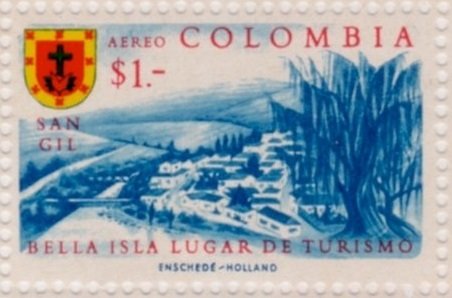Stamp: Coat of Arms, View of San Gil (Colombia 1961)
Coat of Arms, View of San Gil (Colombia 1961)
10 October (Colombia ) within release Issued to honor Atlantico,Cauca and Santander Departments goes into circulation Stamp Coat of Arms, View of San Gil face value 1 Colombian peso
| Stamp Coat of Arms, View of San Gil in catalogues | |
|---|---|
| Michel: | Mi: CO 990 |
| Stamp Number: | Sn: CO C409c |
| Leo Temprano: | Lt: CO HF24a |
Stamp is horizontal format.
Stamp from souvenir sheet MI BL23. Printed by Joh. Enschede en Zonen, Netherlands. Designed by Mosdóssy. Founded in 1689, San Gil is over 300 years old. It was officially named the tourist capital of the region in 2004, thanks to its outdoor activity opportunities such as rafting, caving, kayaking and hiking.San Gil played an important role during the Colombian independence period. "Comuneros" rebels came from nearby regions, united, traveled to the capital, Bogota, and fought for the nation's independence, a process which occurred during the early 1820s.Also in the issue Issued to honor Atlantico,Cauca and Santander Departments:
- Stamp - Ships in Barranquilla Harbour face value 50;
- Stamp - Easter week procession in Popayàn face value 50;
- Stamp - Monastery Hotel,Popayàn face value 50;
- Stamp - Coat of Arms, View of San Gil face value 1;
- Stamp - Arms of Bucaramanga face value 50;
- Stamp - Arms of Barranquilla face value 35;
- Stamp - Arms of Popayan face value 40;
Stamp Coat of Arms, View of San Gil it reflects the thematic directions:
A coat of arms is an heraldic visual design on an escutcheon (i.e. shield), surcoat, or tabard. The coat of arms on an escutcheon forms the central element of the full heraldic achievement which in its whole consists of shield, supporters, crest, and motto. A coat of arms is traditionally unique to an individual person, family (except in the United Kingdom), state, organisation or corporation.
A landscape is the visible features of an area of land, its landforms and how they integrate with natural or man-made features. A landscape includes the physical elements of geophysically defined landforms such as (ice-capped) mountains, hills, water bodies such as rivers, lakes, ponds and the sea, living elements of land cover including indigenous vegetation, human elements including different forms of land use, buildings and structures, and transitory elements such as lighting and weather conditions. Combining both their physical origins and the cultural overlay of human presence, often created over millennia, landscapes reflect a living synthesis of people and place that is vital to local and national identity. The character of a landscape helps define the self-image of the people who inhabit it and a sense of place that differentiates one region from other regions. It is the dynamic backdrop to people’s lives. Landscape can be as varied as farmland, a landscape park, or wilderness. The earth has a vast range of landscapes, including the icy landscapes of polar regions, mountainous landscapes, vast arid desert landscapes, islands and coastal landscapes, densely forested or wooded landscapes including past boreal forests and tropical rainforests, and agricultural landscapes of temperate and tropical regions.
In the visual arts, a cityscape (urban landscape) is an artistic representation, such as a painting, drawing, print or photograph, of the physical aspects of a city or urban area. It is the urban equivalent of a landscape. Townscape is roughly synonymous with cityscape, though it implies the same difference in urban size and density (and even modernity) implicit in the difference between the words city and town. In urban design the terms refer to the configuration of built forms and interstitial space.


